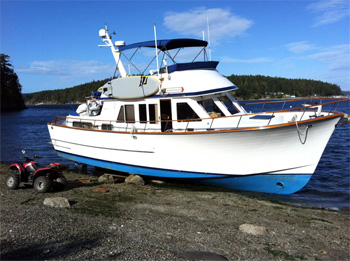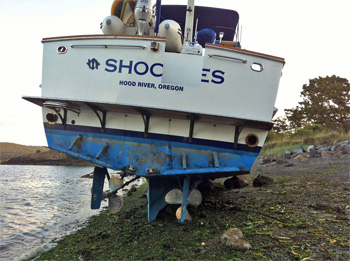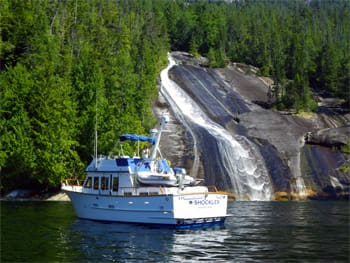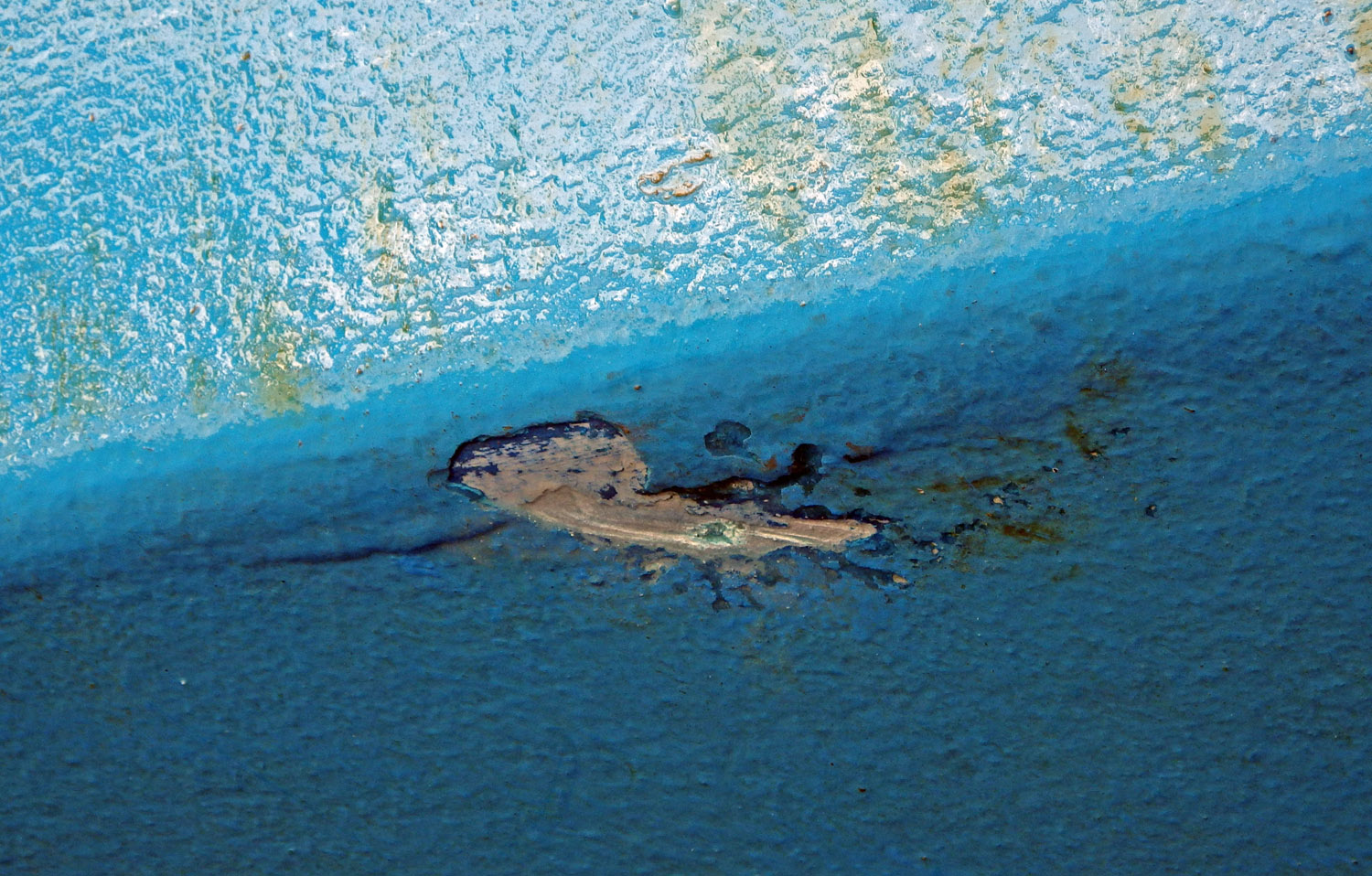There are three kinds of boaters: those who have gone aground, those who will go aground, and those who have gone aground but lie about it.
My wife Debbie and I and our friends Scott and Dawn were on my boat Shockles, a 43-foot Ocean Alexander power voyaging boat, for a leisurely September cruise in Washington’s San Juan Islands. After three glorious days we were heading back to our home port of Anacortes and our final night out. The weather forecast called for southwest winds 10 to 20 knots, so we circled Decatur Island looking for a snug cove to anchor in with exposure to the north.
We ended up at Reads Bay, which is a bit exposed but it provided more room to choose a spot to anchor.
 |
|
Shockles on the beach at Reads Bay. |
We dropped the anchor 100 yards from shore in 10 feet of water. I opted for my usual anchoring technique of not letting out more than 3:1 scope and not setting the anchor but letting it lie so it can reset itself, but Scott convinced me it was inadequate, so to keep the peace I relented. Debbie let out 60 feet of chain (6:1) and we backed down on the anchor to make sure it was holding. It set in solidly and there was plenty of room to swing should the wind change. Scott decided to find us some dinner so he donned his scuba gear. Forty-five minutes later he was back with a bag full of crabs. “I dove on the anchor and it’s set deep in the mud,” Scott reported. “It would take a tsunami to move it.” Good news since the wind was forecast to build.
We had a big dinner and around 2200 we went to bed.
BAM!
I sat bolt upright in bed. What the hell was that??
BAM!
Debbie snapped awake.
BAM!
I jumped out of bed and bounded up into the saloon. It was pitch black and I could just barely make out Scott in the saloon in his flannel jammies staring out the window.
BAM!
What the hell…?
“I think we’ve moved,” he said. The wind was howling and an erratic rain was pelting the windows.
“Moved?”
“Yeah, look at that tree. I don’t think it was there before.”
I squinted into the darkness and could just make out a small tree lashed by the wind.
“Yeah… and what about that house… wasn’t that farther away…?”
“Um… I think we dragged.”
BAM!
I stared out the window. “WE’RE ON SHORE!”
BAM!
I turned on our weather instruments and it was suddenly quite obvious: the wind had switched from south to north, it was blowing a gale, the temperature had dropped 30 degrees, it was raining sideways, for some unknown reason we were no longer anchored where we started, and the boat was slamming against the shore. I donned my foul weather gear, grabbed a big flashlight and went outside.
I shone the light down over the edge of the rail and into the water. Yes, there was water. It was around a foot deep, and there were two barnacle-covered boulders just breaking the surface.
The side of the boat rose as a surge of wind and wave hit the other side and propelled it upward onto the rocks. The waves were slamming hard into the windward side.
I watched in stunned silence as the boat rose up and settled down onto one of the rocks. “We aren’t anchored?”
 |
|
In a bizarre coincidence, Shockles came to rest on a rock that supported the vessel and caused only minor damage to the hull.
|
Scott and I headed up to the bow to determine what happened. The anchor chain was slack. I grabbed it and pulled hard, expecting it to grab, but nothing happened. As I pulled, it slid along the bottom easily and within a minute I saw a huge clump of mud and kelp where there should be a 45-pound steel anchor. It’s in there somewhere, I assume, but it is so bound up with clay and seaweed that it couldn’t possibly bite into the bottom.
We scurried back to the middle of the boat and shone our lights all along the beach… which was about five feet away. The “beach” was a steep gravel bank studded with large boulders that were embedded into the bottom, their surfaces covered with razor-sharp barnacles. It was impossible to tell how big they actually were. Scott courageously leapt over the railing and into the water to see if there was any chance we could still motor off the beach. I headed inside and fired up the generator, just in case.
I turned on our electronics and the screens of the depth sounder and GPS lit up. Depth: 0. Boat position on the chartplotter: on shore.
I checked the tide. It was about a foot below high tide. I stared at the screen trying to discern whether the tide was rising or falling. In my adrenaline-fueled state I decided it was rising. Scott, back on board and equally delusional, agreed and we headed back outside to make a plan.
“Maybe we can start the port motor and it will pull the stern back out,” Scott suggested.
We scurried to the stern to assess this first idea. I aimed my light into the water and the beam immediately revealed several big boulders just five feet away. Nope. We headed back inside to think of something else.
Debbie said, “Um, we think that the tide is falling, not rising.”
Dawn pointed to the computer screen with the tide chart. I stared at it, still not comprehending. Indeed, it indicated that the tide was falling. Fast. In fact it will be going down another five feet in the next five hours.
It took a moment for this new knowledge to sink in. It was 0100, the boat was getting smashed on the rocks as we stood here completely unable to do a thing about it. I went back outside and peered down at the two large rocks just inches away from the chine where the side of the hull meets the bottom. As each wave hit the windward side of the boat, the hull rose and banged down on the closest rock.
“Well,” I announced, “we’re on the beach and we’re not getting off any time soon. The tide will keep going out until around six thirty. At least at this point the wind is keeping us pinned on these rocks so we might not tip over. We might as well try to get some sleep and deal with this in the morning.”
I looked out again and saw the owner of the house standing on the bank above us. “Not much you can do now,” he yelled into the wind. “Tide’s going out. I’ll see you in the morning.”
Scott and I took one last look around, surveyed the wind and waves slamming into the port side and the rocks that were now out of the water and propped against our hull on the starboard side. The tide was still receding fast — luckily for us — and the violent lurching was subsiding. It was back to bed.
I woke up around 0600. On the port side the ocean was now several yards away from the side of the boat. On the starboard side the beach was… right there. I opened the sliding door and stepped out onto the side deck to survey the damage. The rain had stopped and a light breeze was quickly clearing the remaining clouds away; it was a beautiful day. Too bad we were on the beach.
I went to the swim platform and hopped down onto solid ground. It was hard, compact gravel. The keel, rather than having dug into the muck, was sitting smartly on the surface. The tide was slack and the water was about 10 feet out from the keel on the port side.
As I walked around the boat it occurred to me how incredibly lucky we were. Five feet behind the stern were several large boulders that we somehow avoided. Ten feet off the bow was a virtual minefield of big, nasty rocks that we just missed. On the beach side were three rocks imbedded into the gravel: one was a couple feet from the keel, supporting the hull; one was supporting the edge of the hull; and the third — a nasty boulder with two large horns sticking out — we didn’t touch. With the boat fully supported by the keel, and leaning at a 10° tilt onto the two solid but rounded rocks, it was as if we had been gently dropped down there by a travel lift in preparation for bottom paint.
The props and rudders were still several inches above the gravel beach, totally unscathed. In fact, other than a little chipped paint on the very edge of the hull where it was supported by the rock, the boat was completely undamaged.
Scott and I jumped down onto the beach to check things out. The owner of the house showed up. He reassured us that this has happened before and we should be able to float off when the tide came back in. I took my iPhone to the high tide mark on the beach and open up my clinometer app that shows inclination, stuck it down in the gravel until it read level, and sighted along the edge of the phone to see where the water level will be at high tide: about a foot above my boat’s waterline, meaning she’ll float away at high tide.
That’s the other amazingly lucky thing: we went aground when the tide was receding, about a foot and a half under high tide. Had the tide been coming in, we would have gotten smashed on the horn-shaped boulder. Had it been high tide, we wouldn’t be able to float off when the next tide occurred. Had it been low tide we would have been floating again at 0300 in the wind and pitch dark. So now, in theory, all we had to do was wait until the tide came back in and call for assistance to get us pulled off the beach.
I called my insurance company and was told to do whatever it takes to keep the boat safe and repaired and keep all my receipts. Then I called Vessel Assist and asked them to show up at 1100, about two hours before high tide. Then we all climbed back aboard my boat, made a big pot of coffee and waited for the water to rise.
At 1100 the towboat showed up. It was pretty small, but had a 250-hp outboard and two operators. They beached their boat in the rapidly rising tide and walked up the beach to talk to me. They assured me they’ve done this many times before. We worked out a plan to hook a line to the bow and have them start pulling gently as the boat began to float. Then when it finally came loose they would tow us out to deeper water.
That was another really lucky thing about where we ended up: while the beach was fairly gradual from the low tide line to the high water mark, it dropped off rapidly, meaning that once we were floating it would be easy to turn the boat seaward without hitting any rocks on the way out.
The predicted 1130 float time came and went with us still hard aground. At noon we were still holding fast. Finally, at around 1230 we started to feel movement and I radioed to the towboat to start putting pressure on the towline. Their tiny aluminum boat skidded back and forth across the water as it pulled on the rope. Ten minutes later I saw the board that we placed between the hull and rock float free. The towboat pulled harder.
At 1255, exactly, 12 hours after we went aground, the boat moved, then floated free as the towboat yanked the line taught and headed away from shore.
I started the engines and soon we were motoring across the bay. The towboat came alongside so we could “settle up.” Because it was such an easy release from the beach, we got a 25 percent discount: total bill, $4,300.
It was a glorious sunny day as we motored the two hours back to the marina. Unbelievably, the boat emerged completely unscathed.
Lessons learned? In theory we did everything right: checked three different weather forecasts (all of which were wrong, including two VHF Coast Guard marine forecasts!), used 6:1 anchor scope, even dove on the anchor to check that it was in a good spot.
In analyzing what happened, it was apparent that the anchor, deeply embedded in the mud since we had backed up on it when we set it, had pried up a huge pile of mud/clay when the wind switched direction and we swung around 180°. This prevented it from resetting itself as we dragged towards shore during the night. Hard to say if it would have set itself properly later had it not been stuck in the mud, but it certainly would have had a better chance.
Also, Scott failed to tell me that although the anchor seemed to be set in the mud, there was a thick covering of eelgrass and kelp around it. I avoid anchoring in such areas for both ecological and safety reasons and if I had known this I would have moved the boat.
In the future I will continue with my ‘tried and true’ technique of 3:1 scope and simply letting the anchor lie and reset itself as needed.
———–
Eric Sanford owns a 42-foot FP Venezia catamaran that is currently docked in Puerto Vallarta, Mexico. A year ago he bought a 43-foot Ocean Alexander power voyager to keep in Anacortes, Wash., for summer cruising. Sanford has more than 15,000 miles of open ocean and inland cruising and racing experience, including crewing on the winning boat in the 2006 Newport-Bermuda race.


